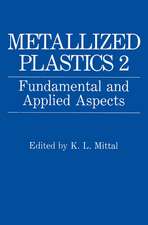Treatise on Clean Surface Technology: Volume 1
Editat de K.L. Mittalen Limba Engleză Paperback – 26 apr 2012
Preț: 390.46 lei
Nou
Puncte Express: 586
Preț estimativ în valută:
74.72€ • 77.72$ • 61.69£
74.72€ • 77.72$ • 61.69£
Carte tipărită la comandă
Livrare economică 14-28 aprilie
Preluare comenzi: 021 569.72.76
Specificații
ISBN-13: 9781468491289
ISBN-10: 1468491288
Pagini: 352
Ilustrații: 348 p.
Dimensiuni: 152 x 229 x 18 mm
Greutate: 0.47 kg
Ediția:Softcover reprint of the original 1st ed. 1987
Editura: Springer Us
Colecția Springer
Locul publicării:New York, NY, United States
ISBN-10: 1468491288
Pagini: 352
Ilustrații: 348 p.
Dimensiuni: 152 x 229 x 18 mm
Greutate: 0.47 kg
Ediția:Softcover reprint of the original 1st ed. 1987
Editura: Springer Us
Colecția Springer
Locul publicării:New York, NY, United States
Public țintă
ResearchCuprins
1. UV/Ozone Cleaning of Surfaces.- 1. Introduction.- 2. The Variables of UV/Ozone Cleaning.- 3. The Mechanism of UV/Ozone Cleaning.- 4. UV/Ozone Cleaning in Vacuum Systems.- 5. Safety Considerations.- 6. UV/Ozone Cleaning Facility Construction.- 7. Applications.- 8. Effects Other Than Cleaning.- 9. Summary and Conclusions.- References and Notes.- 2. Techniques for Cleaning Liquid Surfaces.- 1. Introduction.- 2. The Origin of Dynamic Liquid Surface Phenomena.- 3. The Notion of Surface Cleanliness.- 4. The History of Clean Surfaces.- 5. The Nature of Surface Contamination.- 6. Cleaning Techniques.- 7. Materials for Clean-Surface Experiments.- 8. Cleaning of Apparatus.- 9. General Design Considerations.- 10. Summary.- References.- 3. Hydroson Cleaning of Surfaces.- 1. Introduction.- 2. The Hydroson System.- 3. Experimental Investigation of Mechanisms in the Tank.- 4. Commercial Applications of Hydroson Cleaning.- 5. Safety and Economy.- 6. Recent Developments.- 7. Size and Cost of Equipment.- 8. Comparison with Ultrasonic and Megasonic Cleaning.- 9. Conclusion.- References.- 4. Methods of Measurement of Ionic Surface Contamination.- 1. Introduction.- 2. Ionic Measurement.- 3. Static Extraction Methods.- 4. Dynamic Extraction Method-Ionograph.- 5. Applications of Ionic Contamination Measurements.- 6. Future Prospects.- 7. Summary.- References.- 5. Characterization of Surface Contaminants by Luminescence Using Ultraviolet Excitation.- 1. Introduction.- 2. The Luminescence Technique for Surface Detection.- 3. Applications.- 4. Conclusion.- References.- 6. Particulate Surface Contamination and Device Failures.- 1. Introduction.- 2. Sources of Particulate Contamination.- 3. Effects on Device Performance.- 4. Summary.- References.- 7. Effect of Surface Contamination on the Performance of HVDC Insulators.- 1. Introduction.- 2. General Overview of the Flashover Process.- 3. Deposition of Particles.- 4. Deposition of Moisture.- 5. Thermal Processes.- 6. Localized Electrical Breakdown.- 7. Discharge Growth.- 8. Test Methods to Evaluate Insulator Performance.- 9. Prevention of Flashover.- 10. Conclusions and Future Prospects.- References.- 8. Effect of Surface Contamination on Electric Contact Performance.- 1. Introduction.- 2. Sources of Contamination.- 3. Effects of Contamination.- 4. Contact Resistance Probes for the Detection and Characterization of Contamination.- 5. Summary.- References.- 9. The Role of Surface Contaminants in the Solid-State Welding of Metals.- 1. Introduction.- 2. Role of Contaminants in Preventing Solid-State Welds.- 3. Classification of Surface Contaminants.- 4. Role of Contaminant Properties.- 5. Mechanisms for Elimination of Surface Barriers during Solid-State Welding.- 6. Surface Preparation.- 7. Concluding Remarks.- References.- 10. Surface Contamination and Contact Electrification.- 1. Introduction.- 2. Types of Contaminants.- 3. Identification of Extrinsic Traps.- 4. Effect of Contamination on the Metal.- 5. Conclusion.- References.- 11. Surface Contamination and Biomaterials.- 1. Introduction.- 2. General Principles of Surface Contamination.- 3. Review of Biomaterials Contamination Studies.- 4. Conclusions.- Acknowledgments.- References.- 12. Redispersion of Indoor Surface Contamination and Its Implications.- 1. Introduction.- 2. Measurements of the Redispersion or Resuspension Factor (K).- 3. Measurements of “Transferable” Surface Contamination.- 4. The Contribution of Resuspended Particulates to Exposure.- 5. Concluding Remarks.- Acknowledgment.- References.- 13. Application of Pellicles in Clean SurfaceTechnology.- 1. Introduction.- 2. Pellicles in Integrated Circuit Fabrication.- 3. Protective Films on Optical Data Storage Media.- 4. Summary and Future Prospects.- References.




























